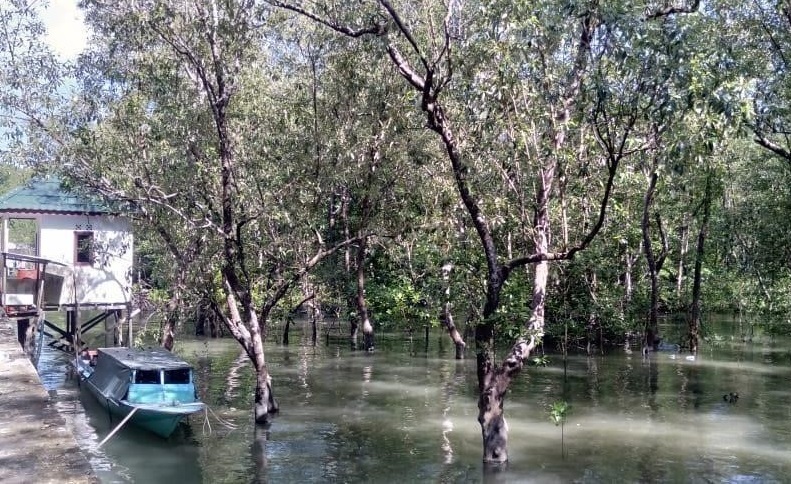Analysis of organic content on sediment and mangrove density in mangrove conservation area, Mamburungan urban village, Tarakan city, Indonesia
DOI:
https://doi.org/10.22219/ijota.v4i2.17518Keywords:
Mangrove, Organic contents, Sediment, TarakanAbstract
The mangrove ecosystem in Mamburungan Village is known to have two dominant types of mangroves, namely Avicennia sp. and Sonneratia sp. The main factors that cause mangrove growth zoning are the type of substrate and the content of organic matter. This research was conducted through several stages, namely, determining the location, preparing tools and materials, taking sediment, and analyzing mangrove data. The highest organic matter content was found at station I of 2.53 % - 17.81 %, and the highest mangrove density ranged from 0.05 ind m-2 - 0.12 ind m-2 which was dominated by Avicennia sp. More organic matter content was found at a depth of 0 cm.
Downloads
References
Amella, Y., Max, R. M., Pujiono, W. P. (2014). Sebaran struktur sedimen, bahan organik, nitrat dan fosfat di perairan dasar Muara Morodemak. Diponogoro Journal of Maquares. 3(4): 208-215.
BPS Tarakan (Central Bureau of Statistics). (2015). Regional Statistics of Tarakan City, Tarakan.
BPS Tarakan (Central Bureau of Statistics). (2018). Regional Statistics of Tarakan City, Tarakan.
Bengen, D. G. (2000). Introduction and management of coastal ecosystems and resources (Proceedings of Training for Integrated Coastal Area Management Trainers). Center for the Study of Coastal and Ocean Resources of IPB. Bogor.
Bengen, D. G. (2001). Pedoman Teknis Pengenalan dan Pengelolaan Ekosistem Mangrove. Center for the Study of Coastal and Marine Resources, Bogor Agricultural Institute. Bogor.
Bengen, D. G. (2002). Ekosistem dan Sumberdaya Alam Pesisir. Pusat Kajian Sumberdaya pesisir dan Lautan. Synopsis. Bogor Agricultural Institute. Bogor.
Budiasih, R., & Supriharyono, S. (2015). Analisis kandungan bahan organik, nitrat, fosfat pada sedimen di kawasan mangrove jenis Rhizophora dan Avicennia di Desa Timbulsloko, Demak. Maquares Journal. (4)3: 66-75.
Citra, L. S, Supriharyono, S., & Suryanti, S. (2020). Analisis kandungan bahan organic, nitrat dan fosfat pada sedimen mangrove jenis Avicennia dan Rhizopora di Desa Tapak Tugurejo, Semarang. Journal of Maquares. 9(2): 107-114.
Fairhurst, R. A., & Graham, K.A. (2003). Seagrass bed-sediment characteristics of Manly Lagoon. In: Freshwater ecology report. Department of Environmental Sciences, University of Technology. Sydney.
Hastuti, Y. P., Lena, N., Tri, W., & Iman, R. (2011). Profile of organic matter in various subgrade depths of Tambak Inti Rakyat, Karawang. Indonesian Journal of Aquaculture. 10(2): 183-191.
State Ministry of Environment. (2004). Decree of the Minister of State for the Environment: 201 of 2004 concerning the criteria for quality standards and guidelines for mangrove damage.
Manengkey, H. W. K. (2010). Kandungan bahan organik pada sedimen di Perairan Teluk Buyat dan Sekitarnya. Jurnal Perikanan dan Kelautan Tropis. 6(3):114-119.
Nontji, A. (2002). Laut Nusantara. PT. Djambatan, Jakarta
Notoatmodjo, S. (2002). Metodologi penelitian kesehatan. Rineka Cipta, Jakarta.
Nugroho, R. A., Sugeng, W., & Rudhi, P. (2013). Studi kandungan bahan organik dan mineral (N, P, K, Fe dan Mg) sedimen di kawasan mangrove Desa Bedono, Kecamatan Sayung, Kabupaten Demak. Journal of Marine Research. 2(1): 62-70.
Parmadi, E. H., Irma, D., & Sofyatuddin, K. (2016). Indeks nilai penting vegetasi mangrove di kawasan Kuala IDI Kabupaten Aceh Timur. Jurnal Ilmiah Mahasiswa Kelautan dan Perikanan Unsyiah. 1(1):82-95.
Simanjuntak, S. L., Max, R. M., & Wiwiet, T. T. (2018). Analisis tekstur sedimen dan bahan organik terhadap kelimpahan makrozoobenthos di muara Sungai Jajar, Demak. Journal of Maquares. 7(4): 423-430.
Wiharyanto, D. & Laga, A. (2010). Kajian pengelolaan hutan mangrove di kawasan konservasi Desa Mamburungan Kota Tarakan Kalimantan Timur. Jurnal Media Sains. 2(1): 10-1.

Downloads
Published
How to Cite
Issue
Section
License
Copyright (c) 2021 IJOTA (Indonesian Journal of Tropical Aquatic)

This work is licensed under a Creative Commons Attribution-ShareAlike 4.0 International License.
IJOTA (Indonesian Journal of Tropical Aquatic) allows readers to read, download, copy, distribute, print, search, or link to its articles' full texts and allows readers to use them for any other lawful purpose. The journal allows the author(s) to hold the copyright without restrictions. Finally, the journal allows the author(s) to retain publishing rights without restrictions
- Authors are allowed to archive their submitted article in an open access repository
- Authors are allowed to archive the final published article in an open access repository with an acknowledgment of its initial publication in this journal

